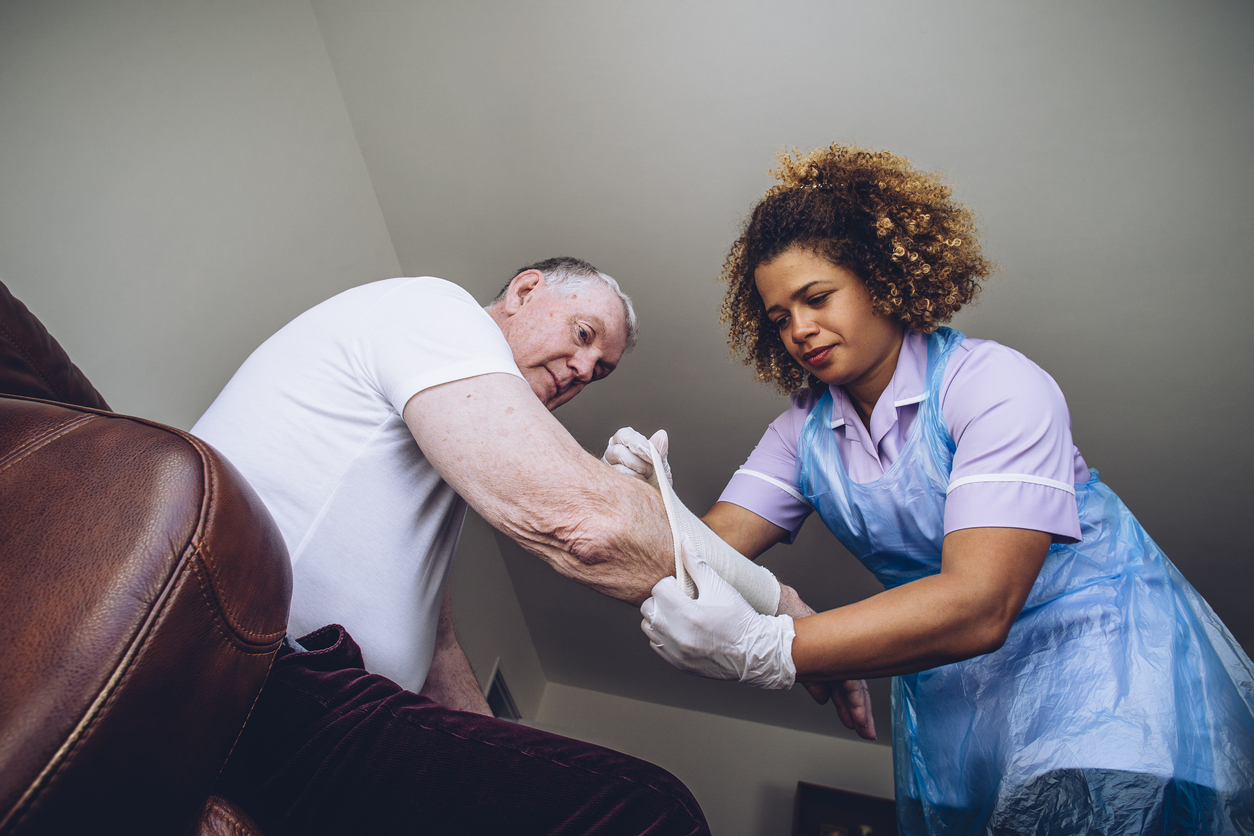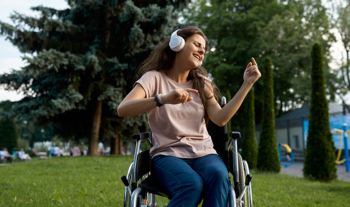Chronic wounds aren’t typically something most people think about. If there is a break in the skin or deep tissue, nature takes over and our bodies begin the healing process.
However, for some adults, especially those who are older or managing health conditions, wound healing – particularly if the wound is chronic – is not as easy.
Chronic wounds are common
Every year, more than 6 million people in the U.S. are affected by chronic wounds such as pressure injuries and foot ulcers[1]. Unlike acute wounds from a surgical incision or an injury, chronic wounds often occur in people with conditions like immobility or diabetes.
These types of wounds don’t necessarily show signs of healing within 30 days. If wounds don’t heal properly, they can lead to some very serious complications.
Because of the associated complications, chronic wounds put a significant financial strain on the health system. It’s estimated that $25 billion is spent annually in the U.S. to treat these wounds. This, plus the inconvenience and setbacks of people afflicted with chronic wounds makes it critical that healthcare providers help patients reduce the risk of wound complications.
Risks factors for chronic wounds
Some of the factors that put a person at higher risk for chronic wounds, include the following [2]:
- older age
- hypertension
- poor nutrition
- chronic lung disease
- diabetes
- obesity
Self-care can make a difference in chronic wound care
I am a nutrition scientist and researcher at a global healthcare company that produces science-backed nutritional therapies. I’ve specialized in wound healing for more than two decades.
My passion is to empower patients and their caregivers with self-care strategies to support continued wound healing at home, as directed by a physician. By focusing on the following areas of wound care, healthcare providers can help patients and caretakers stay on top of their care plan in order to achieve the best outcomes possible.
-
Ensure proper wound dressings and care
To ensure care is continued long after a hospitalization or clinic visit, clinicians should talk to their patients about the appropriate steps to clean their wound and keep a fresh dressing applied to it. This will help prevent germs from contacting the wound while absorbing fluid that drains from the site that could damage the skin surrounding it.
While the best methods for dressing will depend on the individual’s specific type of wound, there are general steps that patients and caregivers should become familiar with handling at home. These include,
-
-
- cleaning the wound each time the dressing is changed,
- applying a fresh dressing, and
- possibly using a compression stocking or bandage to help improve blood circulation and promote healing[3].
-
Lastly, protecting the wound site is important. Patients should be coached to take steps to avoid any additional trauma to the wound. This can help reduce additional setbacks.
For example, if a person has a foot ulcer, it helps to make sure that any shoes or slippers are not aggravating the wound site. Further, directing patients to elevate the affected foot above heart level for 15 to 30 minutes a few times per day may help with swelling and improve blood flow.
-
Don’t underestimate the power of nutrition
Nutrition is often an overlooked part of wound care, however, it can support healing from the inside, out.
Our bodies are designed to heal skin and tissue damage, but only if they have the right tools to make it happen. Good nutrition is one of those critical tools.
For each stage of the healing process, specific nutrients are required. If a person isn’t getting enough of the right nutrients, the wound-healing process can be delayed.
The body needs additional calories as well as protein, amino acids, vitamins, and minerals to generate new tissue at the wound site.
Some of the specific nutrients to prioritize include the following:
-
-
-
- arginine and glutamine, important amino acids during the wound healing process that provide building blocks for new tissue.
- Hydrolyzed collagen is necessary to stimulate the production of internal collagen at the wound site.
- HMB (short for β-hydroxy-β-methyl-butyrate) helps slow muscle protein breakdown
- Zinc supports immune function and skin integrity
- Vitamins C, E, and B12 help strengthen the new skin and to help get more oxygen to the wound site.
-
-
It can sometimes be difficult for a patient to get enough of these key nutrients from diet alone, especially if they are malnourished or managing other health conditions.
Recovery during hospitalization or from illnesses can also take a toll on a patient’s appetite. It can also impact their ability to tolerate certain foods.
When a balanced diet is not enough, there’s a clinically-backed nutrition supplement that supports the wound-healing process by providing essential nutrients that have been shown to enhance collagen formation in as little as two weeks which healthcare providers can recommend.[4]
-
Counsel on the signs of infection
With chronic wounds, there’s no precise timetable for healing. Each patient is unique, and how quickly and efficiently a person’s body recovers from a chronic wound can depend on several factors, ranging from the type and size of the wound to their overall health and nutrition status.
In general, the larger the wound, the longer the recovery process will be. For these patients, enlisting a caregiver for support can be a helpful strategy to make the recovery process easier.
-
When to ask for help
Throughout healing, it’s essential that patients learn how to recognize the signs of a wound that is getting worse instead of better – and when it’s time to seek additional care. These can include,
-
-
- increased levels of pain and discomfort
- redness
- pus, or discharge from the wound site,
- sensitivity
- swelling
- a noticeable odor[5]
-
Remind patients and caregivers to call immediately if they experience any of these symptoms, to ensure the infection is caught and addressed early.
Related Content: What You Need to Know About MRSA and What to Do About It
Support patients during the age of COVID
It’s difficult to predict what the coming months will bring as the COVID-19 pandemic continues. We must recognize that individuals with chronic wounds may feel particularly vulnerable while navigating the healthcare system with its heightened health and safety measures.
This presents healthcare providers with an opportunity to engage with these patients in new ways. From reviewing the best methods for at-home wound care to discussing lifestyle changes and recommending helpful nutrition supplements.
These are simple steps that can go a long way in offering patients and their caregivers the proactive means to take control of their health.
Expanding the channels of support to include telehealth and virtual platforms could also be a valuable way to provide reassurance and emphasize the appropriate steps for at-home care. It also helps avoid unnecessary visits to doctors’ offices, hospitals, or other care facilities for the time being, as appropriate.
Related content: Doximity’s New Telehealth Platform Makes it Easy to Connect
The bottom line
The best way to ensure effective self-care, monitor wound healing, and answer questions as they arise is by scheduling regular check-ins. This allows clinicians to maintain an accessible and open dialogue with patients and caregivers as they deal with a chronic wound.
References:
[1] Sen CK, Gordillo GM, Roy S, et al. Human skin wounds: a major and snowballing threat to public health and the economy. Wound Repair Regen. 2009;17(6):763-771. https://onlinelibrary.wiley.com/doi/abs/10.1111/j.1524-475X.2009.00543.x
[2] Guo S, Dipietro LA. Factors affecting wound healing. J Dent Res. 2010;89(3):219-229. https://journals.sagepub.com/doi/abs/10.1177/0022034509359125
[3] InformedHealth.org. Cologne, Germany: Institute for Quality and Efficiency in Health Care (IQWiG); 2006. What are the treatment options for chronic wounds? 2006 Oct 17 [Updated 2018 Jun 14]. https://www.informedhealth.org/what-are-the-treatment-options-for-chronic-wounds.2706.en.html?part=behandlung-ko
[4] Williams JZ, et al. Ann Surg. 2002; 236:369-374.3 Jones, et all, Surgical Infections, 2014. https://journals.lww.com/annalsofsurgery/Abstract/2002/09000/Effect_of_a_Specialized_Amino_Acid_Mixture_on.13.aspx
Jones, et al., Surgical Infections, 2014;15(6):708-712.): https://www.ncbi.nlm.nih.gov/pmc/articles/PMC4268587/
[5] Frank C, Bayoumi I, Westendorp C. Approach to infected skin ulcers. Can Fam Physician. 2005;51(10):1352-1359: https://www.cfp.ca/content/51/10/1352
Jeffrey Nelson, Ph.D.
Website:
https://www.nutritionnews.abbott/
Dr. Jeffrey Nelson is a Senior Research Scientist and wound expert at Abbott, a global healthcare company and leader in nutrition science.
As part of the Nutrition Scientific and Medical Affairs team, Dr. Nelson is responsible for clinical research in adult therapeutic nutrition and provides scientific support and education for Abbott’s adult specialty nutrition products around the world. With an expertise in wound healing, Dr. Nelson helps healthcare providers and patients address chronic and acute wounds.
The area of research has always been a passion for Dr. Nelson – prior to his impressive 23-year tenure at Abbott, he was a Senior Research Scientist at the Shriners Burns Institute for Burn Injured Children and held an adjunct Assistant Professor position in the Department of Surgery at the University of Cincinnati Medical School in Cincinnati, Ohio.
Dr. Nelson has published more than 50 peer-reviewed manuscripts over the past 30 plus years and conducted research studies on a range of topics including nutrition’s role in hospital malnourishment and readmission rates, diabetic foot ulcer treatment, glucose tolerance, and more. He is a go-to expert on the topic of nutrition and chronic wounds and has given presentations in a number of areas including wound healing, burn trauma, oncology, sepsis, ARDS, diabetes, critical care, health economics, and other nutrition-related topics.
Dr. Nelson obtained his Ph.D. degree from the University of Cincinnati, Cincinnati, Ohio, and is a member of the National Pressure Injury Advisory Panel.








Comment will held for moderation